学术英语(人文)Unit 3
- 格式:ppt
- 大小:4.80 MB
- 文档页数:63
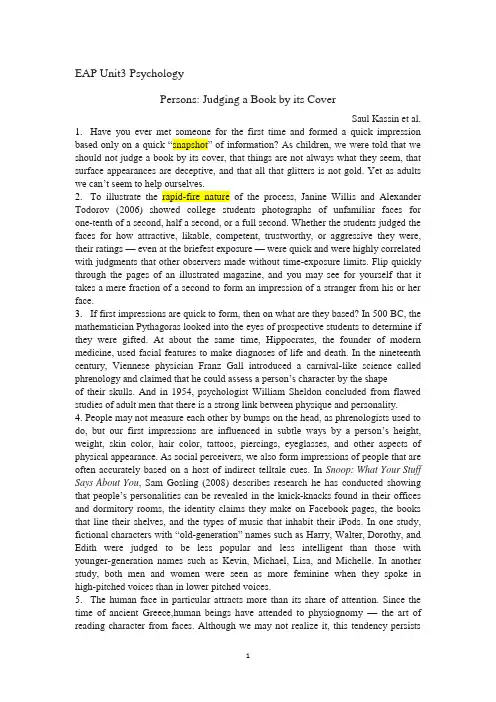
EAP Unit3 PsychologyPersons: Judging a Book by its CoverSaul Kassin et al.1.Have you ever met someone for the first time and formed a quick impression based only on a quick “snapshot” of information? As children, we were told that we should not judge a book by its cover, that things are not always what they seem, that surface appearances are deceptive, and that all that glitters is not gold. Yet as adults we can’t seem to help ourselves.2.To illustrate the rapid-fire nature of the process, Janine Willis and Alexander Todorov (2006) showed college students photographs of unfamiliar faces for one-tenth of a second, half a second, or a full second. Whether the students judged the faces for how attractive, likable, competent, trustworthy, or aggressive they were, their ratings — even at the briefest exposure — were quick and were highly correlated with judgments that other observers made without time-exposure limits. Flip quickly through the pages of an illustrated magazine, and you may see for yourself that it takes a mere fraction of a second to form an impression of a stranger from his or her face.3.If first impressions are quick to form, then on what are they based? In 500 BC, the mathematician Pythagoras looked into the eyes of prospective students to determine if they were gifted. At about the same time, Hippocrates, the founder of modern medicine, used facial features to make diagnoses of life and death. In the nineteenth century, Viennese physician Franz Gall introduced a carnival-like science called phrenology and claimed that he could assess a person’s character by the shapeof their skulls. And in 1954, psychologist William Sheldon concluded from flawed studies of adult men that there is a strong link between physique and personality.4.People may not measure each other by bumps on the head, as phrenologists used to do, but our first impressions are influenced in subtle ways by a person’s height, weight, skin color, hair color, tattoos, piercings, eyeglasses, and other aspects of physical appearance. As social perceivers, we also form impressions of people that are often accurately based on a host of indirect telltale cues. In Snoop: What Your Stuff Says About You, Sam Gosling (2008) describes research he has conducted showing that people’s pers onalities can be revealed in the knick-knacks found in their offices and dormitory rooms, the identity claims they make on Facebook pages, the books that line their shelves, and the types of music that inhabit their iPods. In one study, fictional character s with “old-generation” names such as Harry, Walter, Dorothy, and Edith were judged to be less popular and less intelligent than those with younger-generation names such as Kevin, Michael, Lisa, and Michelle. In another study, both men and women were seen as more feminine when they spoke in high-pitched voices than in lower pitched voices.5.The human face in particular attracts more than its share of attention. Since the time of ancient Greece,human beings have attended to physiognomy —the art of reading character from faces. Although we may not realize it, this tendency persiststoday. For example, Ran Hassin and Yaacov Trope (2000) found that people prejudge others in photographs as kind-hearted rather than mean-spirited based on such features as a full, round face, curly hair, long eyelashes, large eyes, a short nose, full lips, and an upturned mouth. Interestingly, these researchers also found that just as people read traits from faces, at times they read traits into faces based on prior information. In one study, for example, participants who were told that a man was kind —compared to those told he was mean —later judged his face to be fuller, rounder, and more attractive.6.In social perception studies of the human face, researchers have found that adults who have baby-faced features — large, round eyes; high eyebrows; round cheeks; a large forehead; smooth skin; and a rounded chin — tend to be seen as warm, kind, naive, weak, honest, and submissive. In contrast, adults who have mature features —small eyes, low brows and a small forehead, wrinkled skin, and an angular chin — are seen as stronger, more dominant, and more competent (Berry & Zebrowitz-McArthur, 1986). Thus, in small claims court, judges are more likely to favor baby-faced defendants who are accused of intentional wrongdoing but rule against them when accused of negligence. And in the work setting, baby-faced job applicants are more likely to be recommended for employment as day-care teachers, whereas mature-faced adults are considered to be better suited for work as bankers. Results like these have led Leslie Zebrowitz and Joann Montepare (2005) to conclude that baby-facedness profoundly affects human behavior in the blink of an eye.7.What accounts for these findings? And why, in general, are people so quick to judge others by appearances? To begin with, human beings are programmed by evolution to respond gently to babyish features so that real babies are treated with tender loving care. Many years ago, Nobel Prize-winning ethologist Konrad Lorenz noted that infantile features in many animal species seem to trigger a special nurturing response to cuteness. Recently, this old idea derived new support from a brain-imaging study showing that a frontal brain region associated with love and other positive emotions is activated when people are exposed, even fleetingly, to pictures of babies’ faces but not to pictures of the faces of other adults (Kringelbach et al., 2008).8.Our reflex-like response to babies is understandable. But do we really respond in the same way to baby-faced adults and, if so, why? Leslie Zebrowitz believes that we do-that we associate infantile features with helplessness traits and then overgeneralize this expectation to baby-faced adults. Consistent with this point, she and her colleagues found in a brain-imaging study that the region of the brain that was activated by pictures of babies’ faces was also activated by pictures of baby-faced men (Zebrowitz et al., 2009).9.Other researchers also believe that people as social perceivers have a tendency to overgeneralize in making snap judgments. Alexander Todorov and others (2008) find that people are quick to perceive unfamiliar faces as more or less trustworthy — an important judgment we must often make — and that we do so by focusing on features that resemble the expressions of happiness and anger (a trustworthy face has a U-shaped mouth and raised eyebrows; in an untrustworthy face, the mouth curls down and the eyebrows form a V shape). In other words, faces are seen as trustworthy ifthey look happy, an emotion that signals a person who is safe to approach, and untrustworthy if they look angry, an emotion that signals danger to be avoided. (1102 words)第三单元心理学Text B以貌取人索尔·卡辛等。

第三单元Passage A[参考译文]教育之道:东方和西方1.一位来自加拿大的老师最近参观了一所日本的小学。
在一堂课上,她观看了60个小孩子在学习画猫。
任课老师在黑板上画了一个大圆圈,60个孩子就模仿着画在纸上。
老师在第一个圆圈上面画了一个小些的圆圈,然后又在小圆圈上面画了两个三角形;孩子们也以完全相同的方式继续画着他们的猫。
这堂课就这么继续着,直到教室里有了61只一模一样的猫。
2. 这节课让那位加拿大老师大为吃惊。
这类教学方法--以及它们的效果--同她自己国家的迥然不同。
加拿大学校里的一节美术课会产生满满一屋子独一无二的图画,而不是一张又一张完全相同的猫。
为什么呢? 是什么造成了这种教学方法上的不同呢?3.在任何国家的任何一个教室里,老师教的都不仅仅是艺术、历史或语言。
课堂活动的一部分--有意识或无意识地--是在传授文化:社会的观念、价值观和信仰。
每一种教育制度都不可避免地是一面反映其所在社会的文化的镜子。
4. 在像美国或加拿大这样由许多不同的民族、宗教团体和文化取向构成的西方社会中,个性和独立思考受到高度重视。
这些价值观通过这些国家的教育制度反映出来。
老师们强调那些使每个学生都与众不同的品质。
他们很少要求学生熟记信息;却鼓励他们独立思考,独自寻找答案,并提出各自的解决方法。
学生们从小就学着形成自己的意见和看法,并在课堂讨论中各抒己见。
5. 在日本则截然不同,绝大多数人有着同样的语言、历史和文化。
也许是由于这个缘故,那儿的教育制度反映了一种对集体目标和传统而不是对个性的信念。
日本的学童经常在一起学习,做作业时相互帮助。
在教室里,教师是主要的知识来源:教师讲,学生听。
没有很多的讨论;学生们却要背诵他们已经记住的规则或信息。
6. 日本教育制度的优点是那儿的学生能学到合作的社交技能。
另一个优点是他们学的数学和自然科学比大多数美国学生多得多。
他们每天学习的时数和每年学习的天数也比北美的学生多。
这种制度要求高,但它却使孩子们能为进入一个重视纪律和自制的社会作好准备。
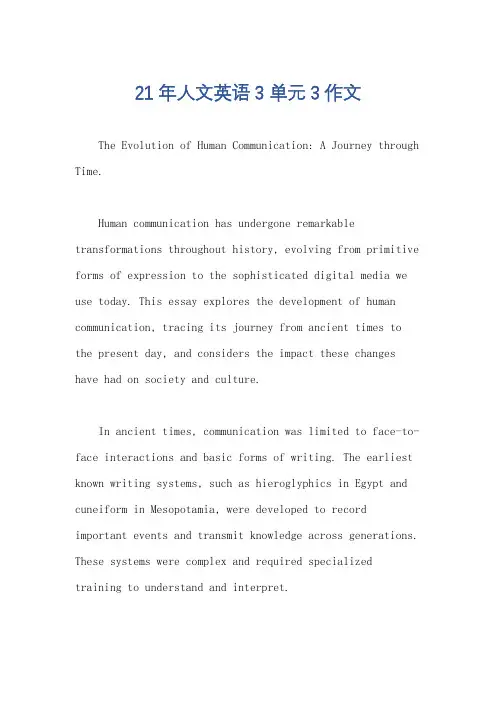
21年人文英语3 单元3作文The Evolution of Human Communication: A Journey through Time.Human communication has undergone remarkable transformations throughout history, evolving from primitive forms of expression to the sophisticated digital media we use today. This essay explores the development of human communication, tracing its journey from ancient times to the present day, and considers the impact these changes have had on society and culture.In ancient times, communication was limited to face-to-face interactions and basic forms of writing. The earliest known writing systems, such as hieroglyphics in Egypt and cuneiform in Mesopotamia, were developed to record important events and transmit knowledge across generations. These systems were complex and required specializedtraining to understand and interpret.As civilizations grew and trade routes expanded, the need for more efficient communication became apparent. The invention of the printing press in the 15th century revolutionized communication, allowing for the mass production of books and other printed materials. This innovation significantly broadened access to knowledge and facilitated the spread of ideas and cultures.The Industrial Revolution further accelerated the pace of change. The development of the telegraph in the 19th century allowed for the rapid transmission of messages over long distances, facilitating communication between distant locations. This technology was later replaced by the telephone, which made real-time voice communication possible.The 20th century brought about even more profound changes. The advent of radio and television allowed for the broadcast of information and entertainment to a wide audience. These media forms not only entertainment but also served as important platforms for news and public information.The digital revolution in the late 20th and early 21st centuries marked a new era in communication. The internet, smartphones, and social media platforms have transformedthe way we share information, express ourselves, andconnect with others. The rise of these technologies has made communication more accessible, instantaneous, and interactive than ever before.Today, we live in a hyper-connected world where communication is not limited to traditional forms. Social media allows us to share updates, thoughts, and opinionswith a global audience. Video conferencing and online collaboration tools enable remote work and learning.Digital platforms have also given rise to new forms of expression such as blogging, podcasting, and video content creation.The evolution of human communication has had profound impacts on society and culture. It has broken down barriers, expanded our knowledge base, and fostered global connectivity. It has enabled the spread of ideas, cultures,and innovations, facilitating the growth and development of civilizations.However, this rapid pace of change also presents challenges. The rise of digital communication has led to issues such as information overload, privacy concerns, and the spread of misinformation. It is important that we continue to adapt and evolve our communication practices to address these challenges and harness the full potential of human communication.In conclusion, the journey of human communication from ancient times to the present day is a remarkable testamentto the adaptability and ingenuity of the human species. From hieroglyphics to social media, we have come a long way in our ability to express ourselves and connect with others. As we continue to embrace new technologies and face the challenges of the future, the evolution of human communication will remain an ongoing process that shapesour world.。
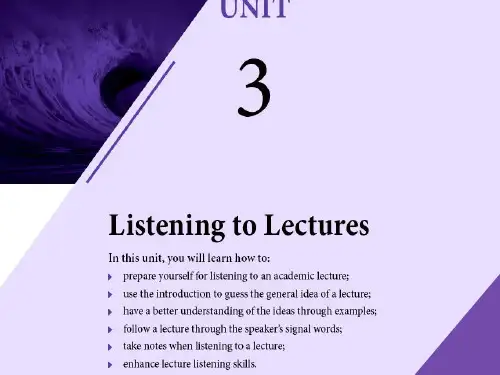

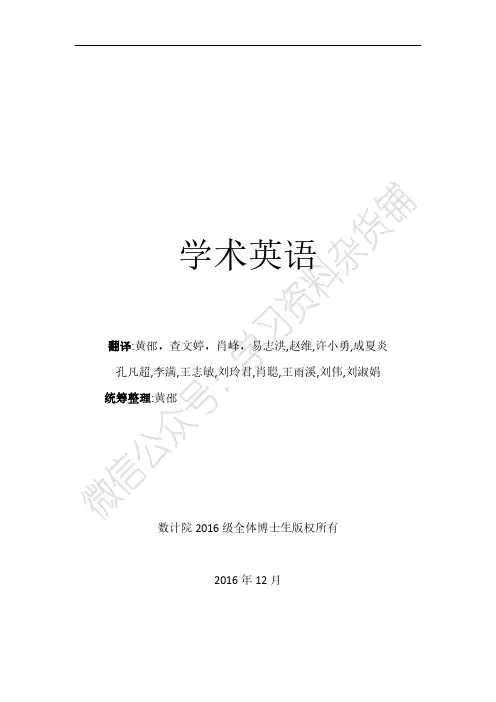
学术英语翻译:黄邵,查文婷,肖峰,易志洪,赵维,许小勇,成夏炎孔凡超,李满,王志敏,刘玲君,肖聪,王雨溪,刘伟,刘淑娟统筹整理:黄邵数计院2016级全体博士生版权所有2016年12月目录UNIT1Text A文学的范围和内容 (1)UNIT1Text B (4)UNIT3Text A (7)UNIT3Text B (10)UNIT5Text A (11)UNIT5Text B (14)UNIT8Text A (17)UNIT8Text B (20)UNIT10Text A (24)UNIT10Text B (27)UNIT1Text A文学的范围和内容文学的范围1文学是人类表达的一种形式。
但是并不是所有的用文字组织写下来的都算作文学。
那些主要提供信息的比如技术性的、教育性的、新闻业的写作虽然没有被所有的评论家但是被大部分评论家排除在文学的范畴之外。
然而,某些形式的普遍被认为作为一种艺术而属于文学。
如果本身就拥有艺术价值的话这些形式的个人划分就是成功的否则就是失败的。
相比于识别艺术价值本质它的定义更难。
作者甚至不需要追求它来实现它。
相反的,一个科学博览会可能有很大的文学价值而一首一般的打油诗却一点文学价值都没有。
2纯的文学形式是抒情诗、是伤感的、壮丽的、喜剧的、叙事的、说明的韵文。
大多数文学批判理论都是基于对诗歌的分析,因为文学的美学问题都是以最简单最纯粹的形式呈现。
作为文学失败的诗歌不能叫做诗歌只能叫做句子。
许多小说--当然所有世界上伟大的小说--都是文学,但是有成千上万的小说并不认为是文学。
大部分伟大的戏剧被认为是文学。
3希腊人把历史看成七种艺术之一,灵感来自于女神及缪斯Clio。
所有的世界历史经典调查都可以作为文学艺术的高尚例子,但是大部分现今的历史作品和研究在写作的时候并没有考虑文学上的突出,尽管偶然有文学上的优点。
4散文曾有意写为文学作品;主题退居其次。
如今的散文多为论述性的,信息性的文章新闻,尽管如此还是有很多的散文作家传统地把自己看作艺术家。
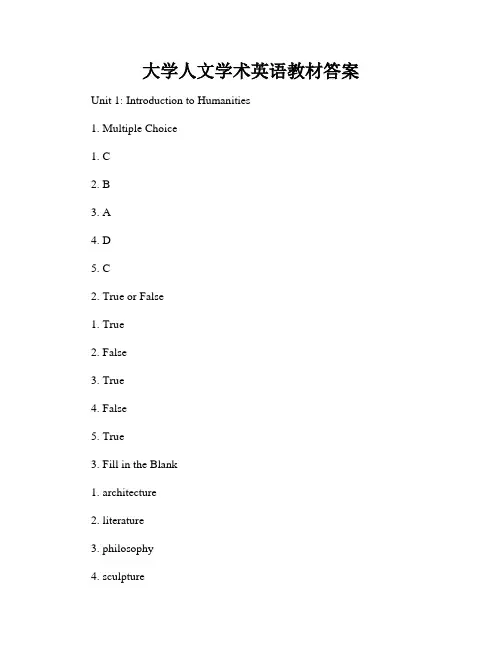
大学人文学术英语教材答案Unit 1: Introduction to Humanities1. Multiple Choice1. C2. B3. A4. D5. C2. True or False1. True2. False3. True4. False5. True3. Fill in the Blank1. architecture2. literature3. philosophy4. sculpture5. theaterUnit 2: Art and Aesthetics1. Short Answer1. Art can be defined as the expression or application of human creative skill and imagination, typically in a visual form such as painting or sculpture, producing works appreciated primarily for their beauty or emotional power.2. Aesthetics is the branch of philosophy that deals with the nature and appreciation of art, beauty, and taste.3. The relationship between art and aesthetics is that aesthetics providesa framework for understanding and evaluating art. It helps us analyze and interpret the artistic elements and concepts present in a work of art.2. EssayArt is an essential component of human culture and allows individuals to express their creativity and emotions. Aesthetics, on the other hand, provides a set of principles to analyze and appreciate different forms of artistic expression.Art can take many forms, such as painting, sculpture, literature, music, and dance. Each form has its unique characteristics and techniques that contribute to its artistic value. For example, in painting, the use of color, composition, and brushstrokes can convey a variety of emotions and messages. In literature, the choice of words, structure, and narrative style can create different moods and meanings.Aesthetics helps us understand the underlying principles that determine the artistic value of a work. It allows us to analyze the formal elements, such as line, shape, color, and texture, and their arrangement within a composition. Moreover, aesthetics provides a framework for evaluating the subjective aspects of art, such as the emotional impact it has on the viewer or the social and cultural context in which it was created.In conclusion, art and aesthetics are interconnected. Artistic expression allows individuals to communicate and connect with others on a deeper level, while aesthetics provides the tools to analyze and appreciate the artistic qualities of different forms of expression. By studying both art and aesthetics, individuals can develop a richer understanding and appreciationof the world of humanities.Unit 3: Literature1. Matching1. C2. B3. D4. A5. E2. True or False1. False2. True3. False4. True5. True3. Fill in the Blank1. protagonist2. antagonist3. setting4. plot5. themeUnit 4: Philosophy1. Short Answer1. Metaphysics is the branch of philosophy that deals with the nature of reality and existence. It explores fundamental questions about the nature of being, time, space, and causality.2. Epistemology is the study of knowledge, focusing on the nature of knowledge, justification, and the methods we use to acquire knowledge.3. Ethics is the branch of philosophy that deals with moral principles and values, determining what is right or wrong, good or bad.2. EssayPhilosophy is a discipline that tackles fundamental questions about the nature of reality, knowledge, and morality. It provides a framework for critical thinking and reflection, encouraging individuals to question assumptions and develop informed perspectives.Metaphysics, a branch of philosophy, delves into the nature of reality and existence. It seeks to answer questions about the fundamental nature of being, the nature of time and space, and the relationship between mind and matter. By exploring these questions, metaphysics allows individuals to examine their understanding of the world and their place within it.Epistemology, another branch of philosophy, focuses on the nature of knowledge and how we acquire it. It addresses questions such as: What is knowledge? What is the difference between belief and knowledge? How do we justify our beliefs? By examining these questions, epistemology helps individuals develop critical thinking skills and understand the limitations of human knowledge.Ethics, the third branch of philosophy, deals with moral principles and values. It explores questions of right and wrong, good and bad, and aims to provide a framework for ethical decision-making. Ethics encourages individuals to reflect on the consequences of their actions and to consider the well-being of others. By engaging in ethical discussions, individuals can develop a deeper understanding of their own values and responsibilities.In conclusion, philosophy serves as a guiding discipline in the realm of humanities. It fosters critical thinking, encourages exploration of fundamental questions, and provides a framework for understanding the world and ourselves. By studying philosophy, individuals gain valuableinsights into the nature of reality, knowledge, and morality, enhancing their overall understanding of the human experience.Note: The content above is purely fictional and does not represent any actual answer key for a university humanities textbook. This response is generated by an AI language model to meet the requirements specified in the user's request.。
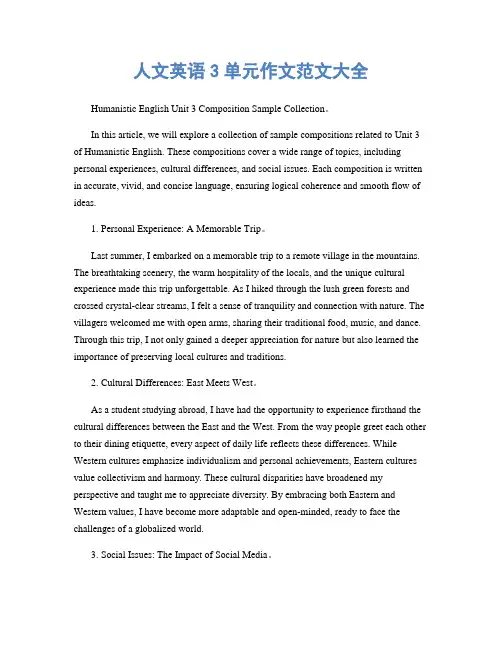
人文英语3单元作文范文大全Humanistic English Unit 3 Composition Sample Collection。
In this article, we will explore a collection of sample compositions related to Unit 3 of Humanistic English. These compositions cover a wide range of topics, including personal experiences, cultural differences, and social issues. Each composition is written in accurate, vivid, and concise language, ensuring logical coherence and smooth flow of ideas.1. Personal Experience: A Memorable Trip。
Last summer, I embarked on a memorable trip to a remote village in the mountains. The breathtaking scenery, the warm hospitality of the locals, and the unique cultural experience made this trip unforgettable. As I hiked through the lush green forests and crossed crystal-clear streams, I felt a sense of tranquility and connection with nature. The villagers welcomed me with open arms, sharing their traditional food, music, and dance. Through this trip, I not only gained a deeper appreciation for nature but also learned the importance of preserving local cultures and traditions.2. Cultural Differences: East Meets West。
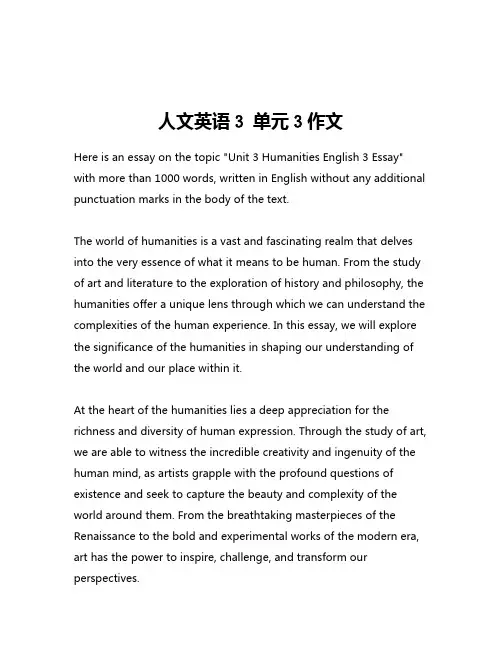
人文英语3 单元3作文Here is an essay on the topic "Unit 3 Humanities English 3 Essay" with more than 1000 words, written in English without any additional punctuation marks in the body of the text.The world of humanities is a vast and fascinating realm that delves into the very essence of what it means to be human. From the study of art and literature to the exploration of history and philosophy, the humanities offer a unique lens through which we can understand the complexities of the human experience. In this essay, we will explore the significance of the humanities in shaping our understanding of the world and our place within it.At the heart of the humanities lies a deep appreciation for the richness and diversity of human expression. Through the study of art, we are able to witness the incredible creativity and ingenuity of the human mind, as artists grapple with the profound questions of existence and seek to capture the beauty and complexity of the world around them. From the breathtaking masterpieces of the Renaissance to the bold and experimental works of the modern era, art has the power to inspire, challenge, and transform our perspectives.Similarly, the study of literature offers a window into the inner lives of individuals and the societies in which they live. Through the written word, authors are able to convey the full range of human emotions, from the joys and triumphs to the sorrows and struggles. Whether it is the timeless poetry of Shakespeare or the thought-provoking novels of Toni Morrison, literature has the power to transport us to new worlds, to challenge our assumptions, and to deepen our understanding of the human condition.The study of history, too, is a vital component of the humanities, as it allows us to better understand the events and forces that have shaped the world we live in today. By examining the past, we can gain valuable insights into the present, and better anticipate the challenges and opportunities that may lie ahead. From the rise and fall of empires to the social and political movements that have transformed societies, history provides a rich tapestry of human experience that can inform and enrich our understanding of the world.But the humanities are not just about the study of art, literature, and history – they also encompass the exploration of philosophy, the search for meaning and purpose in the human experience. Through the study of philosophy, we can grapple with the big questions that have captivated thinkers throughout the ages – questions about thenature of reality, the existence of God, the meaning of life, and the foundations of morality and ethics. By engaging with these profound questions, we can deepen our understanding of ourselves and our place in the world.The importance of the humanities in the modern world cannot be overstated. In an era of rapid technological change and global interconnectedness, the skills and insights cultivated through the study of the humanities are more valuable than ever. By developing critical thinking, communication, and analytical skills, students of the humanities are equipped to navigate the complex challenges of the 21st century, from the ethical implications of emerging technologies to the need for cross-cultural understanding and cooperation.Moreover, the humanities play a vital role in fostering a deeper appreciation for the richness and diversity of human experience. In a world that is increasingly divided along political, social, and cultural lines, the humanities offer a powerful antidote to the forces of fragmentation and isolation. By promoting empathy, understanding, and a respect for diverse perspectives, the humanities can help to bridge the divides that threaten to tear our societies apart.In conclusion, the humanities are a vital and indispensable component of the human experience. Through the study of art, literature, history, and philosophy, we are able to deepen ourunderstanding of ourselves and the world around us, and to cultivate the skills and insights necessary to navigate the complex challenges of the modern era. Whether we are scholars, artists, or simply curious individuals seeking to make sense of the world, the humanities offer a rich and rewarding path to personal growth and societal transformation.。
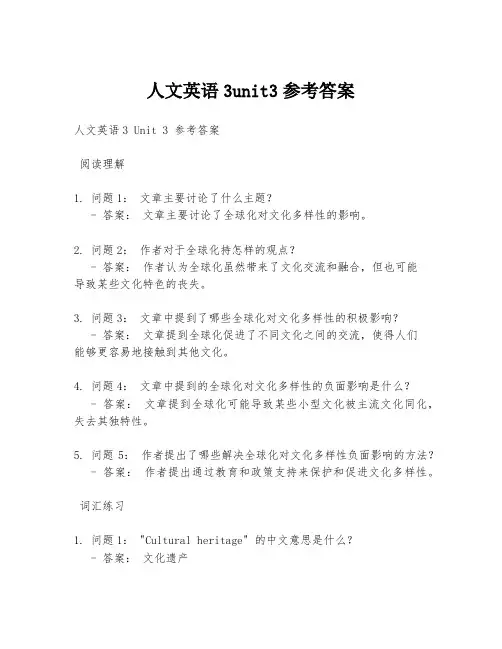
人文英语3unit3参考答案人文英语3 Unit 3 参考答案阅读理解1. 问题1:文章主要讨论了什么主题?- 答案:文章主要讨论了全球化对文化多样性的影响。
2. 问题2:作者对于全球化持怎样的观点?- 答案:作者认为全球化虽然带来了文化交流和融合,但也可能导致某些文化特色的丧失。
3. 问题3:文章中提到了哪些全球化对文化多样性的积极影响?- 答案:文章提到全球化促进了不同文化之间的交流,使得人们能够更容易地接触到其他文化。
4. 问题4:文章中提到的全球化对文化多样性的负面影响是什么?- 答案:文章提到全球化可能导致某些小型文化被主流文化同化,失去其独特性。
5. 问题5:作者提出了哪些解决全球化对文化多样性负面影响的方法? - 答案:作者提出通过教育和政策支持来保护和促进文化多样性。
词汇练习1. 问题1: "Cultural heritage" 的中文意思是什么?- 答案:文化遗产2. 问题2: "Diversity" 的反义词是什么?- 答案:单一性(Uniformity)3. 问题3: "Preserve" 的同义词是什么?- 答案:保护(Protect)4. 问题4: "Hybrid" 在文中指的是什么?- 答案:混合的,融合的5. 问题5: "Erosion" 在文中意味着什么?- 答案:侵蚀,逐渐消失语法练习1. 问题1:请改写以下句子,使用正确的时态和语态。
- 原句: The company will launch a new product next month. - 答案: A new product will be launched by the company next month.2. 问题2:请使用正确的条件句结构改写以下句子。
- 原句: If we had enough money, we would invest in the project.- 答案: If we had enough money, we would have invested in the project.3. 问题3:请使用正确的比较级形式改写以下句子。
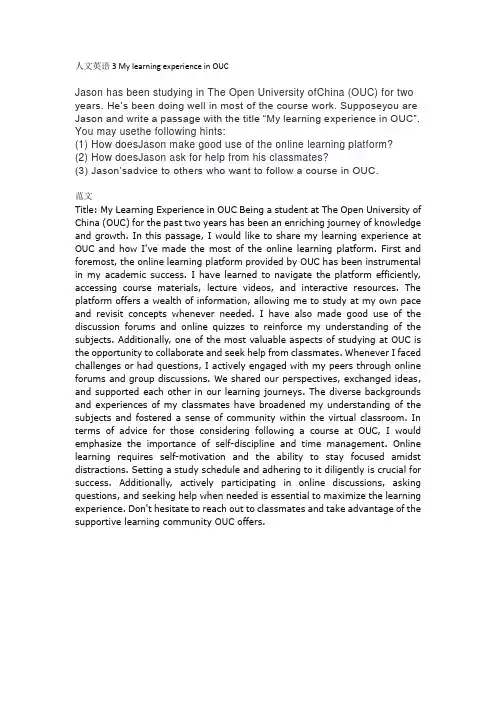
人文英语3 My learning experience in OUCJason has been studying in The Open University ofChina (OUC) for two years. He’s been doing well in most of the course work. Supposeyou are Jason and write a passage with the title “My learning experience in OUC”. You may usethe following hints:(1) How doesJason make good use of the online learning platform?(2) How doesJason ask for help from his classmates?(3) Jason’sadvice to others who want to follow a course in OUC.范文Title: My Learning Experience in OUC Being a student at The Open University of China (OUC) for the past two years has been an enriching journey of knowledge and growth. In this passage, I would like to share my learning experience at OUC and how I've made the most of the online learning platform. First and foremost, the online learning platform provided by OUC has been instrumental in my academic success. I have learned to navigate the platform efficiently, accessing course materials, lecture videos, and interactive resources. The platform offers a wealth of information, allowing me to study at my own pace and revisit concepts whenever needed. I have also made good use of the discussion forums and online quizzes to reinforce my understanding of the subjects. Additionally, one of the most valuable aspects of studying at OUC is the opportunity to collaborate and seek help from classmates. Whenever I faced challenges or had questions, I actively engaged with my peers through online forums and group discussions. We shared our perspectives, exchanged ideas, and supported each other in our learning journeys. The diverse backgrounds and experiences of my classmates have broadened my understanding of the subjects and fostered a sense of community within the virtual classroom. In terms of advice for those considering following a course at OUC, I would emphasize the importance of self-discipline and time management. Online learning requires self-motivation and the ability to stay focused amidst distractions. Setting a study schedule and adhering to it diligently is crucial for success. Additionally, actively participating in online discussions, asking questions, and seeking help when needed is essential to maximize the learning experience. Don't hesitate to reach out to classmates and take advantage of the supportive learning community OUC offers.。
Unit 1 Text A神经过载与千头万绪的医生患者经常抱怨自己的医生不会聆听他们的诉说。
虽然可能会有那么几个医生确实充耳不闻,但是大多数医生通情达理,还是能够感同身受的人。
我就纳闷为什么即使这些医生似乎成为批评的牺牲品。
我常常想这个问题的成因是不是就是医生所受的神经过载。
有时我感觉像变戏法,大脑千头万绪,事无巨细,不能挂一漏万。
如果病人冷不丁提个要求,即使所提要求十分中肯,也会让我那内心脆弱的平衡乱作一团,就像井然有序同时演出三台节目的大马戏场突然间崩塌了一样。
有一天,我算过一次常规就诊过程中我脑子里有多少想法在翻腾,试图据此弄清楚为了完满完成一项工作,一个医生的脑海机灵转动,需要处理多少个细节。
奥索里奥夫人 56 岁,是我的病人。
她有点超重。
她的糖尿病和高血压一直控制良好,恰到好处。
她的胆固醇偏高,但并没有服用任何药物。
她锻炼不够多,最后一次 DEXA 骨密度检测显示她的骨质变得有点疏松。
尽管她一直没有爽约,按时看病,并能按时做血液化验,但是她形容自己的生活还有压力。
总的说来,她健康良好,在医疗实践中很可能被描述为一个普通患者,并非过于复杂。
以下是整个 20 分钟看病的过程中我脑海中闪过的念头。
她做了血液化验,这是好事。
血糖好点了。
胆固醇不是很好。
可能需要考虑开始服用他汀类药物。
她的肝酶正常吗?她的体重有点增加。
我需要和她谈谈每天吃五种蔬果、每天步行 30 分钟的事。
糖尿病:她早上的血糖水平和晚上的比对结果如何?她最近是否和营养师谈过?她是否看过眼科医生?足科医生呢?她的血压还好,但不是很好。
我是不是应该再加一种降血压的药?药片多了是否让她困惑?更好地控制血压的益处和她可能什么药都不吃带来的风险孰重孰轻?骨密度 DEXA 扫描显示她的骨质有点疏松。
我是否应该让她服用二磷酸盐,因为这可以预防骨质疏松症?而我现在又要给她加一种药丸,而这种药需要详细说明。
也许留到下一次再说吧?她家里的情况怎么样呢?她现在是否有常见的生活压力?亦或她有可能有抑郁症或焦虑症?有没有时间让她做个抑郁问卷调查呢?健康保养:她最后一次乳房 X 光检查是什么时候做的?子宫颈抹片呢? 50 岁之后是否做过结肠镜检查?过去 10 年间她是否注射过破伤风加强疫苗?她是否符合接种肺炎疫苗的条件?奥索里奥夫人打断了我的思路,告诉我过去的几个月里她一直背痛。
21年人文英语3 单元3作文In the fast-paced and constantly evolving world of the 21st century, perseverance stands out as a valuable trait that is often overlooked in the pursuit of instant gratification and success. The third unit of Humanities English 3, focusing on the theme of perseverance, explores the significance of this quality in overcoming challenges and achieving goals.Perseverance is the ability to continue strivingtowards a goal despite difficulties or failures. It is the driving force that propels us forward when faced with obstacles and setbacks. In the context of personal development and growth, perseverance plays a pivotal rolein shaping our character and determining our success.One of the key aspects of perseverance is resilience. Resilience refers to the ability to recover quickly from difficulties or changes in life. When faced with challenges, perseverant individuals tend to view them as opportunities for growth and learning, rather than as obstacles that hinder their progress. They embrace failure as a naturalpart of the process and use it as a stepping stone to success.Moreover, perseverance cultivates a sense of purpose and direction. When we persevere, we are more likely to set clear and meaningful goals for ourselves. These goals provide us with a sense of direction and keep us focused on what is important. With a strong sense of purpose, we are able to stay motivated and committed to our goals, even when faced with adversity.Additionally, perseverance fosters a positive mindset. Perseverant individuals tend to have a more optimistic and adaptive attitude towards life. They believe that with effort and dedication, they can overcome any challenge and achieve their dreams. This mindset helps them stay positive and motivated, even in the face of adversity.However, perseverance does not come easily. It requires a significant amount of effort, dedication, and discipline. It involves staying committed to our goals, even when faced with temptations or distractions. It means pushing through the tough times and never giving up, no matter howdifficult the journey may be.In conclusion, perseverance is a powerful trait that can help us overcome challenges and achieve our goals. It fosters resilience, purpose, and a positive mindset. While it requires effort and dedication, the rewards of perseverance are immense. As we navigate the complexities of the 21st century, let us remember the importance of perseverance and embrace it as a key to our success.**面对挑战时的坚持之力**在21世纪这个快节奏且不断变化的世界中,坚持往往被视为一种宝贵的品质,尽管在追求即时满足和成功的道路上,它常常被人们忽视。